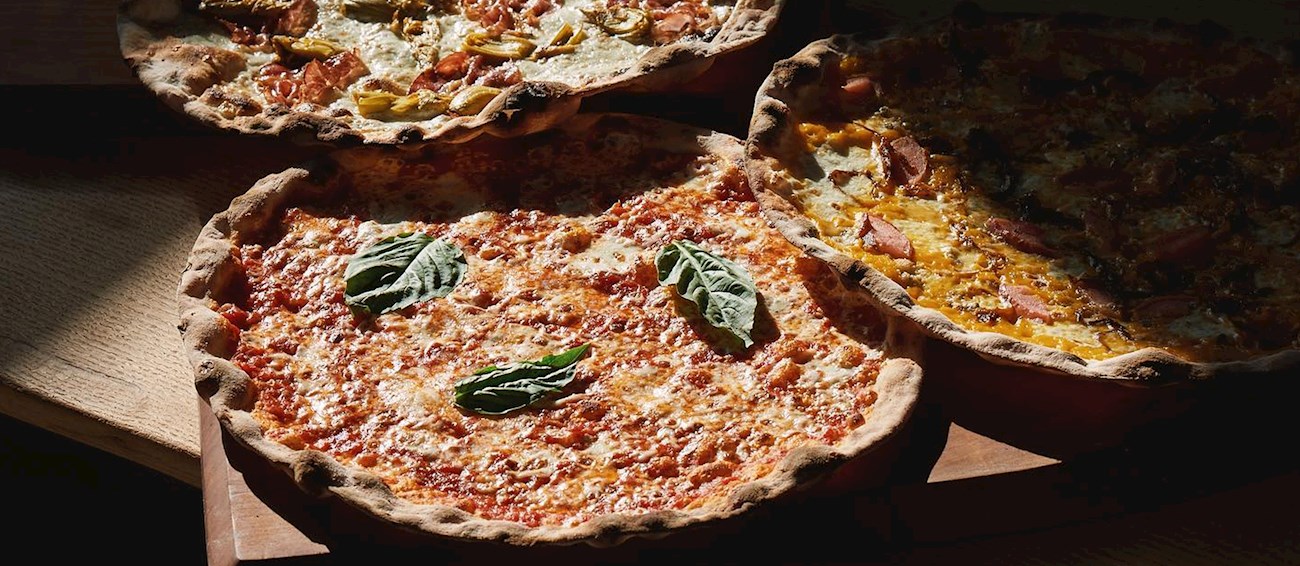Pizza al taglio is a variety of Italian pizza that is baked in rectangular trays and sold sliced into squares or rectangles. Prices can be marked either per slice of pizza or per kilogram. The first pizza al taglio was baked in Rome in the late 1950s, when it was topped with olive oil and tomato sauce.
Today, the dish is one of the most loved street food items both in Rome and in most of Italy. When making pizza al taglio, it is important to let the dough rise and ferment for a longer period of time. The dough is usually baked, topped, and then baked once more, resulting in an evenly-cooked pizza that's light, airy, and easily digestable.
MOST ICONIC Pizza al taglio
View moreThe main thing about pizza Romana is its crust: thin, extremely crunchy, and almost cracker-like, which is why it is also known under the name scrocchiarella, meaning the crunchy one. There are a few things that make this pizza so light and crispy: olive oil - added to the basic dough - and less water in the mixture - the maximum hydration of the dough is up to 55 %.
Due to a harder consistency, this dough must be stretched with a rolling pin, unlike the softer Neapolitan variety that is shaped by hand with almost acrobatic moves while being tossed in the air. Once shaped, the dough is covered with a sparse layer of tomato sauce and chosen toppings – they can vary, but the most traditional combination would include mozzarella, anchovies, capers, chopped basil, and pecorino.
MOST ICONIC Pizza Romana
View morePinsa romana is an ancient Italian dish and the ancestor to the classic pizza we know today. The main ingredient is pinsa romana flour, a mix of wheat flour type 0, soy flour, rice flour, and dried mater dough. This ancient pizza has an oval (or sometimes rectangular) shape, the higher hydration of the dough (making it more digestible), and the dough contains less fats and carbohydrates than regular pizza.
The dough for pinsa romana is always prepared with cold water. In ancient Rome, pinsa was prepared by poor peasants, and the name is derived from the word pinsere, meaning to stretch or to spread, referring to the dough and its elongated shape.
MOST ICONIC Pinsa romana
View moreMAIN INGREDIENTS
Typically shared among groups and consumed by the slice, the Roman invention known as pizza alla pala is a long, oval-shaped flatbread made with a high-hydration, long-rising dough. It is baked in electric ovens, transferred to a wooden board called pala, then topped with various fresh ingredients.
The pizza is characterized by a thick crust and a tender, fluffy interior, while the toppings can be anything from prosciutto and cherry tomatoes to various cheeses, olives, and spicy salami.
Pizza bianca or white pizza is a variety of pizza which omits tomato sauce from the equation, often substituting it with pesto or sour cream. In Rome, pizza bianca is prepared with no sauce whatsoever, and it is instead topped with salt and olive oil, while chopped rosemary is sometimes sprinkled on top.
There are numerous versions of pizza bianca, and the toppings vary accordingly, but the crucial element in all of them is that there should not be any kind of red sauce on the dough.
Pizza e fichi is a variety of pizza bianca, which is usually topped with mozzarella, garlic, salt, olive oil, and, sometimes, rosemary leaves. This Roman version of pizza bianca, called pizza e fichi, is essentially the same, apart from the fact that it is additionally topped with chopped pieces of succulent figs.
The best figs are available in September, or sometimes in late August, making pizza e fichi a highly seasonal pizza variety.
TasteAtlas food rankings are based on the ratings of the TasteAtlas audience, with a series of mechanisms that recognize real users and that ignore bot, nationalist or local patriotic ratings, and give additional value to the ratings of users that the system recognizes as knowledgeable. TasteAtlas Rankings should not be seen as the final global conclusion about food. Their purpose is to promote excellent local foods, instill pride in traditional dishes, and arouse curiosity about dishes you haven’t tried.





